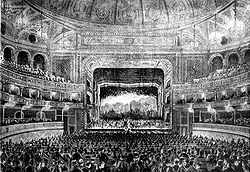
Teatro Dal Verme
Encyclopedia

Milan
Milan is the second-largest city in Italy and the capital city of the region of Lombardy and of the province of Milan. The city proper has a population of about 1.3 million, while its urban area, roughly coinciding with its administrative province and the bordering Province of Monza and Brianza ,...
, Italy located on the Via San Giovanni sul Muro, on the site of the former private theatre the Politeama Ciniselli. It was designed by Giuseppe Pestagalli to a commission from Count Francesco Dal Verme, and was used primarily for plays and opera
Opera
Opera is an art form in which singers and musicians perform a dramatic work combining text and musical score, usually in a theatrical setting. Opera incorporates many of the elements of spoken theatre, such as acting, scenery, and costumes and sometimes includes dance...
performances throughout the 19th and early 20th centuries. Today, the theatre is no longer used for opera, and is a venue for concerts, plays and dance performances, as well as exhibitions and conferences.
The original 3000-seat theatre, surmounted by a large cupola
Cupola
In architecture, a cupola is a small, most-often dome-like, structure on top of a building. Often used to provide a lookout or to admit light and air, it usually crowns a larger roof or dome....
, was constructed in the traditional horseshoe shape, with two tiers of boxes and a large gallery (or loggione) which alone contained more than 1000 seats. It opened on September 14, 1872 with a production of Meyerbeer's Les Huguenots
Les Huguenots
Les Huguenots is a French opera by Giacomo Meyerbeer, one of the most popular and spectacular examples of the style of grand opera. The opera is in five acts and premiered in Paris in 1836. The libretto was written by Eugène Scribe and Émile Deschamps....
and soon established itself as one of Italy's most important opera houses. During its "golden years", the theatre saw the world premieres of Puccini's Le Villi
Le Villi
Le Villi is an opera-ballet in two acts composed by Giacomo Puccini to an Italian libretto by Ferdinando Fontana, based on the short story Les Willis by Jean-Baptiste Alphonse Karr. Karr's story was in turn based in the Central European legend of the Willis, also used in the ballet Giselle...
(May 31, 1884); Leoncavallo's Pagliacci
Pagliacci
Pagliacci , sometimes incorrectly rendered with a definite article as I Pagliacci, is an opera consisting of a prologue and two acts written and composed by Ruggero Leoncavallo. It recounts the tragedy of a jealous husband in a commedia dell'arte troupe...
(May 21, 1892) and I Medici
I Medici
I Medici is an opera composed by Ruggero Leoncavallo, with a libretto by the composer.-Performance history:It premièred at the Teatro Dal Verme in Milan on 9 November 1893. It was not successful in its day and has never become part of the standard repertoire.-Roles:-Synopsis:The opera is set in...
(November 9, 1893); and Cowen
Frederic Hymen Cowen
Sir Frederic Hymen Cowen , was a British pianist, conductor and composer.-Early years:Cowen was born Hymen Frederick Cohen at 90 Duke Street, Kingston, Jamaica, the fifth and last child of Frederick Augustus Cohen and Emily Cohen née Davis. His siblings were Elizabeth Rose Cohen ; actress,...
's Signa
Signa (opera)
Signa is an opera originally conceived in four acts with music by the British composer Frederic H. Cowen with a libretto by Gilbert Arthur à Beckett, with revisions by H.A. Rudall and Frederic Edward Weatherly after Ouida, with an Italian translation by G.A. Mazzucato, first performed in a reduced...
(November 12, 1893). It also saw the Italian premiere of Lehár
Franz Lehár
Franz Lehár was an Austrian-Hungarian composer. He is mainly known for his operettas of which the most successful and best known is The Merry Widow .-Biography:...
's The Merry Widow (April 27, 1907).
By the 1930s, the theatre was mainly being used as a cinema. It was then severely damaged by American aerial bombardment during World War II, after which its magnificent central cupola, which had survived the bombing, was stripped of all its metal parts by the occupying German army. It was partially rebuilt in 1946, and for a period in the 1950s it was used for the performance of musicals
Musical theatre
Musical theatre is a form of theatre combining songs, spoken dialogue, acting, and dance. The emotional content of the piece – humor, pathos, love, anger – as well as the story itself, is communicated through the words, music, movement and technical aspects of the entertainment as an...
. It then reverted to a cinema and a political conference hall.
In 1991, the theatre's interior underwent a major restructuring and renovation project which was completed in 1998. It now has a large modern auditorium, the Sala Grande, with 1420 seats, a smaller performing space known as the Sala Piccola, with 200 seats, and a space for exhibitions and conferences, the Sala Terrazzo. Since September 2001, it has been administered by the Fondazione I Pomeriggi Musicali, whose orchestra is resident at the theatre.
Sources
- Teatro Dal Verme article on Italian Wikipedia
- Exterior photo of the Teatro Dal Verme from Secco Sistemi, a company involved in the renovation of the theatre.

